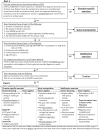Inter-rater reliability of a modified version of Delitto et al.'s classification-based system for low back pain: a pilot study
- PMID: 27559279
- PMCID: PMC4984810
- DOI: 10.1179/2042618614Y.0000000082
Inter-rater reliability of a modified version of Delitto et al.'s classification-based system for low back pain: a pilot study
Abstract
Study design: Observational inter-rater reliability study.
Objectives: To examine: (1) the inter-rater reliability of a modified version of Delitto et al.'s classification-based algorithm for patients with low back pain; (2) the influence of different levels of familiarity with the system; and (3) the inter-rater reliability of algorithm decisions in patients who clearly fit into a subgroup (clear classifications) and those who do not (unclear classifications).
Methods: Patients were examined twice on the same day by two of three participating physical therapists with different levels of familiarity with the system. Patients were classified into one of four classification groups. Raters were blind to the others' classification decision. In order to quantify the inter-rater reliability, percentages of agreement and Cohen's Kappa were calculated.
Results: A total of 36 patients were included (clear classification n = 23; unclear classification n = 13). The overall rate of agreement was 53% and the Kappa value was 0·34 [95% confidence interval (CI): 0·11-0·57], which indicated only fair inter-rater reliability. Inter-rater reliability for patients with a clear classification (agreement 52%, Kappa value 0·29) was not higher than for patients with an unclear classification (agreement 54%, Kappa value 0·33). Familiarity with the system (i.e. trained with written instructions and previous research experience with the algorithm) did not improve the inter-rater reliability.
Conclusion: Our pilot study challenges the inter-rater reliability of the classification procedure in clinical practice. Therefore, more knowledge is needed about factors that affect the inter-rater reliability, in order to improve the clinical applicability of the classification scheme.
Keywords: Agreement; Classification; Low back pain; Physical therapy; Reliability; Subgrouping.
Figures



Similar articles
-
Clinician's ability to identify neck and low back interventions: an inter-rater chance-corrected agreement pilot study.J Man Manip Ther. 2011 Aug;19(3):172-81. doi: 10.1179/2042618611Y.0000000001. J Man Manip Ther. 2011. PMID: 22851880 Free PMC article.
-
Reliability of a treatment-based classification system for subgrouping people with low back pain.J Orthop Sports Phys Ther. 2012 Sep;42(9):797-805. doi: 10.2519/jospt.2012.4078. Epub 2012 Jun 7. J Orthop Sports Phys Ther. 2012. PMID: 22677525
-
The inter-rater and intra-rater reliability of passive physiological accessory movement assessment of lumbar spine in novice manual therapists.J Bodyw Mov Ther. 2012 Jul;16(3):289-293. doi: 10.1016/j.jbmt.2011.12.006. Epub 2012 Jan 20. J Bodyw Mov Ther. 2012. PMID: 22703738
-
Intrarater and Inter-rater Reliability of Tibial Plateau Fracture Classifications: Systematic Review and Meta-Analysis.JB JS Open Access. 2024 Oct 3;9(4):e23.00181. doi: 10.2106/JBJS.OA.23.00181. eCollection 2024 Oct-Dec. JB JS Open Access. 2024. PMID: 39364175 Free PMC article. Review.
-
Hemorrhagic transformation after stroke: inter- and intrarater agreement.Eur J Neurol. 2019 Mar;26(3):476-482. doi: 10.1111/ene.13859. Epub 2018 Dec 7. Eur J Neurol. 2019. PMID: 30414302
Cited by
-
Prevalence and reliability of treatment-based classification for subgrouping patients with low back pain.J Man Manip Ther. 2018 Feb;26(1):36-42. doi: 10.1080/10669817.2017.1350328. Epub 2017 Jul 5. J Man Manip Ther. 2018. PMID: 29456446 Free PMC article.
-
The Use of Cluster Analysis by Partitioning around Medoids (PAM) to Examine the Heterogeneity of Patients with Low Back Pain within Subgroups of the Treatment Based Classification System.J Biomed Phys Eng. 2023 Feb 1;13(1):89-98. doi: 10.31661/jbpe.v0i0.2001-1047. eCollection 2023 Feb. J Biomed Phys Eng. 2023. PMID: 36818010 Free PMC article.
References
-
- Borkan JM, Cherkin DC. An agenda for primary care research on low back pain. Spine. 1996;21:2880–4. - PubMed
-
- O’Sullivan P. It’s time for change with the management of non-specific chronic low back pain. Br J Sports Med. 2012;46:224–7. - PubMed
-
- Fritz JM, Cleland JA, Childs JD. Subgrouping patients with low back pain: evolution of a classification approach to physical therapy. J Orthop Sports Phys Ther. 2007;37:290–302. - PubMed
-
- Delitto A, Erhard RE, Bowling RW. A treatment-based classification approach to low back syndrome: identifying and staging patients for conservative treatment. Phys Ther. 1995;75:470–85. - PubMed
LinkOut - more resources
Full Text Sources
Other Literature Sources
